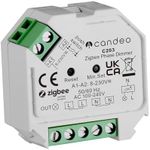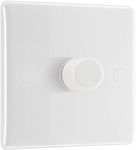Buying Guide for the Best Smart Dimmer Switch
Choosing the right smart dimmer switch can greatly enhance your home's lighting experience, offering convenience, energy savings, and the ability to create the perfect ambiance for any occasion. When selecting a smart dimmer switch, it's important to consider compatibility with your existing lighting system, ease of use, and the features that will best suit your lifestyle. Understanding the key specifications will help you make an informed decision that aligns with your needs and preferences.CompatibilityCompatibility refers to whether the smart dimmer switch can work with your existing lighting setup, including the type of bulbs and the electrical wiring in your home. This is important because not all dimmer switches are compatible with all types of bulbs, such as LED, CFL, or incandescent. Additionally, some smart dimmers require a neutral wire, which may not be present in older homes. To navigate this, check the specifications of the dimmer switch to ensure it supports the type of bulbs you use and matches your home's wiring. If you're unsure, consulting with an electrician can help determine compatibility. Choose a dimmer that aligns with your current setup to avoid installation issues.
Control OptionsControl options refer to the different ways you can operate the smart dimmer switch, such as through a smartphone app, voice commands, or physical touch. This is important because it determines how you interact with your lighting system. Some dimmers offer app control, allowing you to adjust lighting remotely, while others integrate with smart home systems like Amazon Alexa or Google Assistant for voice control. Consider how you prefer to control your lights. If you enjoy using voice commands, ensure the dimmer is compatible with your smart home ecosystem. For those who prefer traditional methods, a dimmer with a physical switch might be more suitable.
Dimming RangeThe dimming range indicates how much you can adjust the brightness of your lights, from the lowest to the highest setting. This is important for creating the right mood and ensuring your lights can be as bright or as dim as you need them to be. Dimming ranges can vary, with some switches offering a wide range and others more limited. To navigate this, consider the typical lighting needs in your space. If you require precise control over brightness for different activities, look for a dimmer with a broad range. For general use, a standard range may suffice.
Integration with Smart Home SystemsIntegration with smart home systems refers to the ability of the dimmer switch to connect and work with other smart devices in your home, such as smart speakers, hubs, or automation systems. This is important for creating a seamless smart home experience where devices can communicate and work together. Some dimmers are compatible with popular systems like Apple HomeKit, Amazon Alexa, or Google Assistant. To navigate this, consider the smart home ecosystem you already use or plan to build. Choose a dimmer that integrates well with your existing devices to enhance functionality and convenience.
Installation ProcessThe installation process involves the steps required to set up the smart dimmer switch in your home. This is important because it affects how easily you can get your new dimmer up and running. Some dimmers are designed for DIY installation with clear instructions, while others may require professional help, especially if your home has older wiring. To navigate this, assess your comfort level with electrical work. If you're experienced, a DIY-friendly model might be suitable. Otherwise, consider a model that offers professional installation services or consult an electrician to ensure safe and proper setup.

















